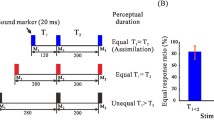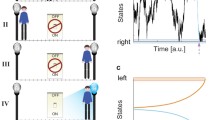Abstract
By constructing Gaussian Naïve Bayes Classifiers, we have re-analyzed data from an earlier event-related potential (ERP) study of an illusion in time perception known as auditory temporal assimilation. In auditory temporal assimilation, two neighboring physically unequal time intervals marked by three successive tone bursts are illusorily perceived as equal if the two time intervals satisfy a certain relationship. The classifiers could discriminate whether or not the subject was engaged in the task, which was judgment of the subjective equality between the two intervals, at an accuracy of >79%, and from principal component scores of individual average ERP waveforms, we were able to predict their subjective judgments to each stimulus at an accuracy of >70%. Chernoff information, unlike accuracy or Kullback–Leibler (KL) distance, suggested brain activation associated with auditory temporal assimilation at an early pre-decision stage. This may provide us with a simple and useful neural decoding scheme in analyzing information processing of temporal patterns in the brain.















Similar content being viewed by others
References
Pfurtscheller G, Lopes da Silva FH (1999) Event-related EEG/MEG synchronization and desynchronization: basic principles. Clin Neurophysiol 110:1842–1857
Buhusi CV, Meck WH (2005) What makes us tick? Functional and neural mechanisms of interval timing. Nat Rev Neurosci 6:755–765
Nakajima Y, ten Hoopen G, van der Wilk RGH (1991) A new illusion of time perception. Music Percept 8:431–448
Miyauchi R, Nakajima Y (2005) Bilateral assimilation of two neighboring empty time intervals. Music Percept 22:411–424
ten Hoopen G, Sasaki T, Nakajima Y, Remijn G, Massier B, Rhebergen KS, Holleman W (2006) Time-shrinking and categorical temporal ratio perception: evidence for a 1:1 temporal category. Music Percept 24:1–22
Kamitani Y, Tong F (2005) Decoding the visual and subjective contents of the human brain. Nat Neurosci 8:679–685
Kay KN, Naselaris T, Prenger RJ, Gallant JL (2008) Identifying natural images from human brain activity. Nature 452:352–355
Bishop CM (2008) Pattern recognition and machine learning. Springer, Amsterdam
Cover TM, Thomas JA (2006) Elements of information theory. Wiley, New York
Mitsudo T, Nakajima Y, Remijn GB, Takeichi H, Goto Y, Tobimatsu S (2009) Electrophysiological evidence of auditory temporal perception related to the assimilation between two neighboring time intervals. NeuroQuantology 7:114–127
Pfeuty M, Ragot R, Pouthas V (2003) When time is up: CNV time course differentiates the roles of the hemispheres in the discrimination of short tone durations. Exp Brain Res 151:372–379
Nicolelis MA, Lebedev MA (2009) Principles of neural ensemble physiology underlying the operation of brain-machine interfaces. Nat Rev Neurosci 10:530–540
Doesburg SM, Kitajo K, Ward LM (2005) Increased gamma-band synchrony precedes switching of conscious perceptual objects in binocular rivalry. Neuroreport 16:1139–1142
Pitts MA, Martínez A, Stalmaster C, Nerger JL, Hillyard SA (2009) Neural generators of ERPs linked with Necker cube reversals. Psychophysiology 46:694–702
Riecke L, Esposito F, Bonte M, Formisano E (2009) Hearing illusory sounds in noise: The timing of sensory-perceptual transformations in auditory cortex. Neuron 64:550–561
Gibbon J, Malapani C, Dale CL, Gallistel C (1997) Toward a neurobiology of temporal cognition: advances and challenges. Curr Opin Neurobiol 7:170–184
Grondin S (2001) From physical time to the first and second moments of psychological time. Psychol Bull 127:22–44
Takeichi H, Mitsudo T, Nakajima Y, Remijn GB, Goto Y, Tobimatsu S (2009) Auditory temporal assimilation: a discriminant analysis of electrophysiological evidence. In: Leung CS, Lee M, Chan JH (eds) ICONIP 2009, Part II, LNCS 5864. Springer, Berlin, pp 299–308
Acknowledgments
This study was partially supported by a Grant-in-aid for scientific research from the Ministry of Education, Culture, Sports, Science and Technology 20530674 to HT, 20653054 and 19103003 to YN and 19390242 to ST. TM was supported by the JSPS Research Fellowships for Young Scientists. The authors are grateful to Drs. Kazuo Ueda, Kimio Shiraishi (Kyushu Univ), Akitoshi Ogawa, Kukjin Kang, Shun-Ichi Amari (RIKEN BSI), Soo-Young Lee (KAIST) for suggestions and discussion.
Author information
Authors and Affiliations
Corresponding author
Rights and permissions
About this article
Cite this article
Takeichi, H., Mitsudo, T., Nakajima, Y. et al. A neural decoding approach to auditory temporal assimilation. Neural Comput & Applic 20, 965–973 (2011). https://doi.org/10.1007/s00521-010-0399-z
Received:
Accepted:
Published:
Issue Date:
DOI: https://doi.org/10.1007/s00521-010-0399-z




